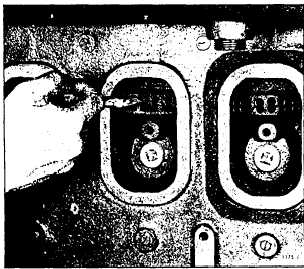Some engines have ports through which pistons can
be inspected. If inspection reveals that the piston is
defective, remove the piston assembly. Figure 3-37
illustrates testing for stuck piston rings through the
scavenging-air port.
If the condition of an engine without cylinder ports
indicates that a piston inspection is required, you must
take the whole piston assembly out of the cylinder.
Engine bearings must be carefully fitted or installed
according to the manufacturer’s instructions. When an
engine cannot be jacked over because of an improperly
fitted bearing, someone probably failed to follow
instructions when the unit was being reassembled.
Engine Cannot Be Cranked but Can Be Barred
Over
You can trace most of the troubles that prevent an
engine from cranking, but not serious enough to prevent
barring over, to the starting system. Although other
factors may prevent an engine from cranking, only
troubles related to starting systems are identified in this
chapter.
If an engine fails to crank when you apply starting
power, first check the turning or jacking gear to be sure
it is disengaged. If this gear is not the source of the
trouble, the trouble is probably with the starting system.
Figure 3-37.—Checking the condition of the piston rings.
Engine Can Be Cranked, but Fails to Start
Although the design of air starting systems may
vary, the function remains the same. In general, such
systems must have a source of air, such as the
compressor or the ship’s air system; a storage tank; air
flask(s); an air timing mechanism; and a valve in the
engine cylinder to admit the air during starting and to
seal the cylinder while the engine is running.
All air starting systems have a unit that admits
starting air to the proper cylinder at the proper time. The
type of unit as well as its name-timer, distributor, air
starting pilot valve, air starting distributor, or air
distributor-may vary from one system to another. The
types of air timing mechanisms are the direct
mechanical lift, the rotary distributor, and the
plunger-type distributor valve. The timing mechanism
of an air starting system is relatively trouble-free except
as noted in the following situations.
DIRECT MECHANICAL LIFT.—The direct
mechanical lift air timing mechanism includes cams,
pushrods, and rocker arms. These parts are subject to the
same failures as engine cams, pushrods, and rocker
arms. Therefore, you can find the causes of trouble in
the actuating gear and the necessary maintenance
procedures under information covering similar engine
parts.
Most troubles are a result of improper adjustment.
Generally, this involves the lift of the starting air cam or
the timing of the air starting valve. The starting air cam
must lift the air starting valve enough to give a proper
clearance between the cam and the cam valve follower
when the engine is running. If there is not enough
clearance between these two parts, hot gases will flow
between the valve and the valve seat, overheating them.
Since the starting air cam regulates the opening of the
air starting valve, check those with adjustable cam lobes
frequently to ensure that the adjusting screws are tight.
Obtain the proper values for lift, tappet clearance,
and time of valve opening for a direct mechanical lift
timing mechanism from the manufacturer’s technical
manual for the particular engine. Make adjustments only
as specified.
ROTARY DISTRIBUTOR.—The
rotary
distributor timing mechanism requires a minimum of
maintenance, but there may be times when the unit
becomes inoperative and you will need to disassemble
and inspect it. Generally, the difficulty is caused by a
scored rotor, a broken spring, or improper timing.
3-25

